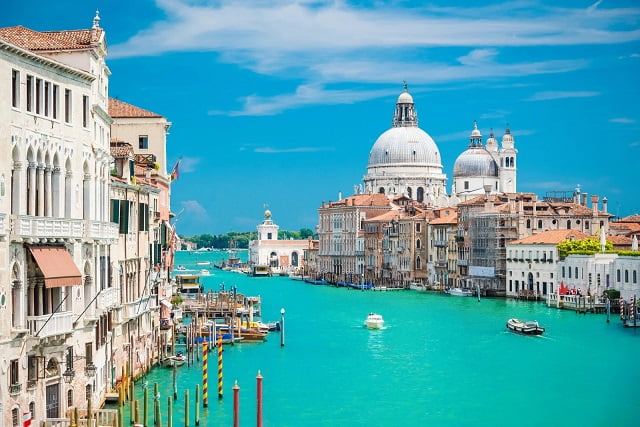When can we travel to Italy in 2021? With the ongoing global pandemic, many individuals are eager to explore the possibility of visiting this iconic European destination.
In this article, we will delve into the current travel situation and restrictions in Italy, providing insights into the latest travel regulations, COVID-19 updates and trends, vaccination requirements, travel planning tips, ideal times to visit, top destinations and attractions worth visiting, as well as the future outlook for travel to Italy in 2021.
As the desire to travel to Italy remains strong in 2021, it is essential for travelers to stay informed about the current travel restrictions and entry requirements due to the ongoing impact of the global pandemic. This article aims to provide a comprehensive overview of what prospective visitors need to know before planning their trip.
From quarantine measures and health screenings to potential changes in travel regulations and restrictions in the coming months, we will explore all aspects related to traveling to Italy this year.
Furthermore, with an emphasis on safety and responsible tourism, understanding the COVID-19 updates and trends in Italy is crucial for anyone considering a trip to this beloved destination. We will discuss how the current COVID-19 situation may impact travel plans and highlight any recent developments or changes related to the pandemic that could affect travel arrangements. Stay tuned as we provide valuable insights for experiencing Italy while navigating through these challenging times.
Current Travel Restrictions in Italy
As of the current year, Italy, like many other countries, has implemented travel restrictions and entry requirements in response to the ongoing COVID-19 pandemic. Travelers considering a trip to Italy in 2021 should be aware of these restrictions and ensure they are up to date with the latest regulations before planning their journey.
As of now, Italy has specific entry requirements for travelers arriving from different countries, particularly regarding testing and quarantine measures. All travelers entering Italy from abroad are required to present a negative PCR test taken within a specified timeframe before arrival.
Additionally, depending on the traveler’s country of origin and any recent travel history, quarantine measures or health screenings may also apply. It is essential for individuals to stay informed about these regulations and comply with them when planning their trip to Italy in 2021.
Moreover, it’s crucial for travelers to regularly check for updates on the COVID-19 situation in Italy as this can directly impact travel plans. Changes in infection rates or government policies may result in new restrictions or guidelines for traveling within the country.
Being aware of these updates will allow individuals to make informed decisions about when they can safely travel to Italy in 2021. Staying informed about COVID-19 trends and developments will also help travelers prioritize their health and safety during their visit.
COVID-19 Updates and Trends in Italy
Current COVID-19 Situation in Italy
As of 2021, Italy continues to navigate the challenges posed by the COVID-19 pandemic. The country has implemented various measures to mitigate the spread of the virus, including regional lockdowns, social distancing guidelines, and the mandatory use of face masks in public places. While these measures have been effective in controlling the spread of the virus, travelers should stay informed about any updates or changes to these regulations when planning a trip to Italy.
Impact on Travel Plans
The ongoing pandemic has undoubtedly had an impact on travel plans for those wishing to visit Italy. Many attractions and public spaces have implemented capacity limits and safety protocols to ensure the health and wellbeing of visitors.
Additionally, travelers may encounter changes in accessibility to certain destinations or experience disruptions in local services due to COVID-19 related restrictions. It is crucial for individuals considering travel to Italy in 2021 to be aware of these potential challenges and plan their trips accordingly.
Travel Flexibility and Contingency Planning
Given the uncertainty surrounding international travel during the pandemic, it is essential for travelers to adopt a flexible approach when making plans to visit Italy. This may involve researching cancellation policies for accommodations and transportation, as well as obtaining travel insurance that offers coverage for unforeseen circumstances related to COVID-19. Additionally, having contingency plans in place can help mitigate any potential disruptions that may arise when visiting Italy in 2021.
Vaccination and Travel to Italy
Italy has been working diligently to combat the COVID-19 pandemic and has made significant progress in its vaccination efforts. As a result, travelers are eager to know when they can travel to Italy in 2021 and what role vaccination plays in this process.
Vaccination Requirements for Travelers
As of now, Italy does not have specific vaccination requirements for travelers entering the country. However, being vaccinated against COVID-19 may become a key factor in facilitating international travel in the near future. It is important for travelers to stay updated on any changes in entry requirements related to vaccination and to ensure that they have received the necessary doses before planning a trip to Italy.
Effect of Vaccination on Travel Plans
The availability of vaccines has reignited hope for travel enthusiasts who are eager to visit Italy. As more people around the world receive their vaccinations, it is expected that travel restrictions will gradually ease, making it easier for vaccinated individuals to enter Italy and enjoy all that it has to offer. Additionally, being vaccinated provides an added layer of protection and peace of mind while traveling.
Considerations for Vaccinated Travelers
While vaccination may not be a strict requirement for traveling to Italy at present, vaccinated individuals should still follow all recommended health guidelines, including wearing masks and practicing social distancing. It is also important to research specific entry requirements for travelers from different countries as these regulations may change based on the global situation. As travel regulations continue to evolve, staying informed about vaccination developments and guidelines will be crucial when making plans to visit Italy in 2021.
Travel Planning Tips for Italy in 2021
As the world continues to grapple with the effects of the COVID-19 pandemic, many people are eagerly anticipating the opportunity to travel again, including to popular destinations like Italy. However, it’s important for travelers to be aware of the current travel situation and the necessary precautions when planning a trip to Italy in 2021.
When can we travel to Italy in 2021? That’s a question on the minds of many individuals who are itching to explore this beautiful country. As of now, it is crucial for travelers to stay updated on the latest travel restrictions and entry requirements in Italy.
This includes being informed about quarantine measures, health screenings, and testing requirements that may be in place for incoming visitors. It’s also important for travelers to stay flexible with their plans and consider purchasing travel insurance with flexible booking options.
Another key consideration for those planning a trip to Italy in 2021 is health precautions. Travelers should be prepared to adhere to safety measures such as wearing face masks in public spaces and practicing social distancing while exploring the country. Additionally, following updates on vaccination requirements or recommendations for travelers will be essential as Italy continues its efforts to combat the spread of COVID-19.
| Travel Planning Tips | Details |
|---|---|
| Stay Informed | Keep up-to-date on travel restrictions and entry requirements |
| Flexibility | Purchase travel insurance with flexible booking options |
| Health Precautions | Adhere to safety measures such as wearing masks and practicing social distancing |
Best Time to Visit Italy in 2021
Many travelers are eager to know when they will be able to visit Italy in 2021, especially given the ongoing global pandemic and its impact on international travel. As of now, Italy has implemented various travel restrictions and entry requirements in response to the COVID-19 situation. These measures include quarantine mandates, health screenings, and testing requirements for incoming travelers.
Currently, the COVID-19 situation in Italy is constantly evolving, and it may have a direct impact on travel plans for those hoping to visit the country in 2021. It is essential for travelers to stay updated on the latest developments and trends related to the pandemic in Italy before making any concrete travel arrangements.
One significant factor that may influence travel to Italy in 2021 is the progress of vaccination efforts. As vaccinations become more widespread, it is possible that certain vaccination requirements or recommendations may be put in place for individuals traveling to Italy. Travelers should monitor updates regarding vaccination guidelines and regulations as they relate to traveling to Italy this year.
Top Destinations and Attractions in Italy
Italy is a country that is rich in history, culture, and natural beauty, making it a top destination for travelers around the world. While the COVID-19 pandemic has certainly impacted travel to Italy, there are still plenty of incredible destinations and attractions to explore when travel restrictions ease. Below are some of the top destinations and attractions in Italy that you should consider visiting in 2021:
1. Rome: As the capital city of Italy, Rome is a must-visit destination for its ancient ruins, historic landmarks such as the Colosseum and Roman Forum, and vibrant street life. When travel restrictions allow, visitors can immerse themselves in the city’s rich history and experience iconic sights like the Vatican City.
2. Florence: Known for its Renaissance art and architecture, Florence is a cultural hub that attracts art enthusiasts from around the world. Visitors can marvel at masterpieces in museums such as the Uffizi Gallery and explore architectural wonders like the Duomo.
3. Venice: Despite challenges posed by overtourism in recent years, Venice remains a unique and enchanting destination with its intricate network of canals, historic palaces, and charming piazzas. Travelers can look forward to experiencing the city’s timeless beauty once it becomes more accessible.
4. Amalfi Coast: This stunning coastline offers breathtaking views of colorful cliffside villages overlooking the Mediterranean Sea. Once travel to this region resumes, visitors can enjoy scenic drives along winding coastal roads or relax on picturesque beaches.
5. Tuscany: With its rolling hills, vineyards, and medieval towns, Tuscany offers a picturesque escape for travelers seeking natural beauty and tranquility. Visitors can look forward to sampling local wines, exploring charming hilltop villages like San Gimignano, or admiring landscapes dotted with cypress trees.
While these destinations hold timeless appeal for travelers to Italy, it’s important to stay informed about current travel restrictions and guidelines before planning any trips. Always check official sources for updates on when can we travel to Italy in 2021 and be prepared to adjust your plans accordingly based on evolving circumstances related to the pandemic.
Future Outlook for Travel to Italy in 2021
As we look ahead to the future of travel to Italy in 2021, there is cautious optimism about the possibility of visiting this popular destination. The ongoing COVID-19 pandemic has significantly impacted travel worldwide, including to Italy. However, as vaccination efforts continue and travel restrictions are being carefully reassessed, there is hope for a potential return to normalcy for travelers eager to experience all that Italy has to offer.
The timing of when can we travel to Italy in 2021 remains uncertain, but several key factors will influence the future outlook for travel to the country. Here are some considerations:
1. Vaccination Rollout: The successful distribution and administration of COVID-19 vaccines will play a crucial role in determining when international travelers can visit Italy. As more people around the world receive vaccination, it is hopeful that travel restrictions may ease.
2. Travel Restrictions and Entry Requirements: Keep an eye on updates regarding entry requirements and travel restrictions for visitors to Italy. These guidelines may evolve as the situation improves or changes.
3. Tourism Recovery Efforts: The Italian government and tourism industry are likely to implement initiatives aimed at encouraging safe and responsible travel, while also supporting local businesses within the tourism sector.
It’s important for prospective travelers to stay informed about these developments when considering a trip to Italy in 2021. Flexibility and adaptability will be key as plans may need to adjust based on the evolving circumstances related to the pandemic. Remember that patience and understanding will be important as we navigate through this unprecedented time in global travel.
Conclusion
In conclusion, the question “When can we travel to Italy in 2021?” remains a pressing concern for many individuals eager to explore the beauty and culture of this captivating country. As of now, Italy has imposed various travel restrictions and entry requirements in response to the ongoing COVID-19 pandemic.
These measures include quarantine mandates, health screenings, and testing requirements for travelers. It is essential for anyone considering a trip to Italy in 2021 to stay updated on these regulations and be prepared to adhere to them.
Additionally, the current COVID-19 situation in Italy continues to evolve, potentially impacting travel plans. Monitoring updates and trends related to the pandemic will be crucial for those planning a visit to Italy. Furthermore, vaccination may play a key role in facilitating safe travel to Italy in 2021. The role of vaccination requirements or recommendations for travelers is an important aspect to consider when making travel arrangements.
As we navigate through this period of uncertainty, it is essential for prospective travelers to remain flexible with their plans. It’s also advisable to take into account practical considerations such as travel insurance, flexible booking options, and health precautions when planning a trip to Italy in 2021. With careful preparation and awareness of the latest developments, it is possible for individuals to make informed decisions regarding their travel ambitions for experiencing all that Italy has to offer in 2021.
Frequently Asked Questions
What Is Required for a US Citizen to Visit Italy?
For a US citizen to visit Italy, a valid passport is required. While a visa is not necessary for stays less than 90 days, travelers must ensure their passport is valid for at least three months beyond the planned departure date from the Schengen area.
Are There Travel Restrictions to Italy?
As of now, there are travel restrictions in place for US citizens traveling to Italy due to the COVID-19 pandemic. Travelers are required to present a negative COVID-19 test result taken within 72 hours before entering Italy and may be subject to quarantine upon arrival.
What Do You Need to Fly to Italy?
When flying to Italy, US citizens need a valid passport as well as any required visas or entry documents based on the purpose of their trip. Additionally, travelers should check for any specific airline requirements and familiarize themselves with Italy’s customs and immigration regulations prior to departure.

I’m a passionate traveler, writer, and Italophile. My fascination with Italy’s history, art, and culture has led me on countless adventures across the Italian landscape. Through “I Live Italy,” I share my love for this extraordinary country and aims to inspire others to explore its boundless beauty.




